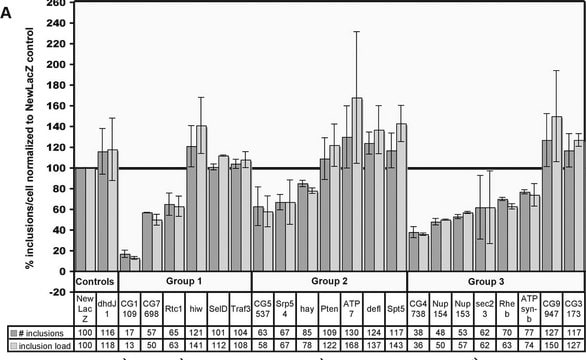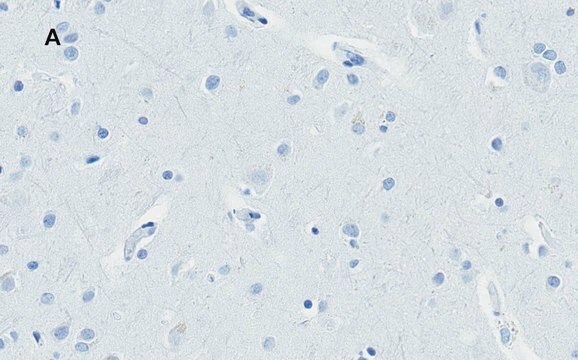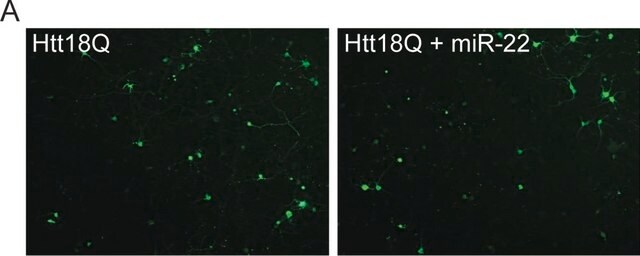추천 제품
생물학적 소스
mouse
Quality Level
결합
unconjugated
항체 형태
purified antibody
항체 생산 유형
primary antibodies
클론
5HU-1H6, monoclonal
분자량
calculated mol wt 347.6 kDa
observed mol wt ~350 kDa
종 반응성
human
포장
antibody small pack of 100 μg
기술
immunocytochemistry: suitable
immunofluorescence: suitable
immunohistochemistry (formalin-fixed, paraffin-embedded sections): suitable
western blot: suitable
동형
IgG1κ
에피토프 서열
N-terminus
단백질 ID 수납 번호
UniProt 수납 번호
배송 상태
dry ice
타겟 번역 후 변형
unmodified
유전자 정보
human ... HTT(3064)
일반 설명
Huntingtin (UniProt: P42858; also known as Huntington disease protein, HD protein) is encoded by the HTT (also known as HD, IT15) gene (Gene ID: 3064) in human. This protein is found in the perinuclear region along with microtubules, and in the centrosomal region along with g-tubulin. It is expressed in the brain and is mainly found in the cerebellar cortex, the neocortex, the striatum, and the hippocampal formation. It plays a role in microtubule-mediated transport or vesicle function and shown to be necessary for neuronal survival. It is involved in synaptic vesicle trafficking, and microtubule binding. It contains a nuclear export signal (aa 2395-2404) and 5 HEAT (Huntington, Elongation Factor 3, PR65/A, TOR) domains. It can undergo cleavage by caspases downstream of the polyglutamine stretch and the resulting N-terminal fragments displays cytotoxicity and provokes apoptosis. In response to DNA damage, it undergoes phosphorylation at Serine 1179 and 1199 by CDK5 that is shown to protect neurons against polyglutamine expansion as well as DNA damage mediated toxicity. The N-terminal fragments of mutant huntingtin (mHTT) misfold and assemble into oligomers that ultimately bundle into insoluble fibrils. Misfolding and self-aggregation of specific proteins is commonly observed in well-known neurodegenerative diseases, including Huntington s disease (HD), Alzheimer s disease (AD), Parkinson s disease (PD), and amyotrophic lateral sclerosis (AML). Abnormal polyglutamine (polyQ) repeat sequence or stretch result in protein misfolding and neurodegeneration.
특이성
Clone 5HU-1H6 is a mouse monoclonal antibody that detects human Huntingtin protein. It targets an epitope within 15 amino acids from the N-terminal region.
면역원
GST-tagged recombinant fragment corresponding to the first 165 amino acids from the N-terminal region of human Huntingtin protein.
애플리케이션
Quality Control Testing
Evaluated by Western Blotting in lysates from HEK293 cells transiently overexpressing Huntingtin protein.
Western Blotting Analysis (WB): A 1:250 dilution of this antibody detected Huntingtin in lysates from HEK293 cells transiently overexpressing Huntingtin protein.
Tested Applications
Western Blotting Analysis: A representative lot detected Huntingtin protein in Western Blotting application. (Miller, J.P., et al. (2010). Neuron. 67(2):199-212; Lunke, A. et al. (2002). Mol Cell. 10(2):259-69; Ratovitski, T., et al. (2007). Cell Cycle. 6(23):2970-81; Michels Thompson, L., et al. (2009). J Cell Biol. 187(7):1083-99; Juenemann, K., et al. (2011). Neurotox Res.;20(2):120-33).
Immunohistochemistry Applications: A representative lot detected Huntingtin protein in Immunohistochemistry application. (Lunke, A. et al. (2002). Mol Cell. 10(2):259-69).
Immunofluorescence Analysis: A representative lot detected Huntingtin protein in Immunofluorescence application. (Juenemann, K., et al. (2011). Neurotox Res.;20(2):120-33).
Immunocytochemistry Analysis: A representative lot detected Huntingtin protein in Immunocytochemistry application. (Miller, J.P., et al. (2010). Neuron. 67(2):199-212; Lunke, A. et al. (2002). Mol Cell. 10(2):259-69).
Note: Actual optimal working dilutions must be determined by end user as specimens, and experimental conditions may vary with the end user
Evaluated by Western Blotting in lysates from HEK293 cells transiently overexpressing Huntingtin protein.
Western Blotting Analysis (WB): A 1:250 dilution of this antibody detected Huntingtin in lysates from HEK293 cells transiently overexpressing Huntingtin protein.
Tested Applications
Western Blotting Analysis: A representative lot detected Huntingtin protein in Western Blotting application. (Miller, J.P., et al. (2010). Neuron. 67(2):199-212; Lunke, A. et al. (2002). Mol Cell. 10(2):259-69; Ratovitski, T., et al. (2007). Cell Cycle. 6(23):2970-81; Michels Thompson, L., et al. (2009). J Cell Biol. 187(7):1083-99; Juenemann, K., et al. (2011). Neurotox Res.;20(2):120-33).
Immunohistochemistry Applications: A representative lot detected Huntingtin protein in Immunohistochemistry application. (Lunke, A. et al. (2002). Mol Cell. 10(2):259-69).
Immunofluorescence Analysis: A representative lot detected Huntingtin protein in Immunofluorescence application. (Juenemann, K., et al. (2011). Neurotox Res.;20(2):120-33).
Immunocytochemistry Analysis: A representative lot detected Huntingtin protein in Immunocytochemistry application. (Miller, J.P., et al. (2010). Neuron. 67(2):199-212; Lunke, A. et al. (2002). Mol Cell. 10(2):259-69).
Note: Actual optimal working dilutions must be determined by end user as specimens, and experimental conditions may vary with the end user
Anti-Huntingtin, a.a. 115-129, clone 5HU-1H6, Cat. No. MAB5490-I, is a mouse monoclonal antibody that detects Huntingtin protein and is tested for use in Immunocytochemistry, Immunofluorescence, Immunohistochemistry, and Western Blotting.
물리적 형태
Purified mouse monoclonal antibody IgG1 in PBS without preservatives.
저장 및 안정성
Store at -10°C to -25°C. Handling Recommendations: Upon receipt and prior to removing the cap, centrifuge the vial and gently mix the solution. Aliquot into microcentrifuge tubes and store at -20°C. Avoid repeated freeze/thaw cycles, which may damage IgG and affect product performance.
기타 정보
Concentration: Please refer to the Certificate of Analysis for the lot-specific concentration.
면책조항
Unless otherwise stated in our catalog or other company documentation accompanying the product(s), our products are intended for research use only and are not to be used for any other purpose, which includes but is not limited to, unauthorized commercial uses, in vitro diagnostic uses, ex vivo or in vivo therapeutic uses or any type of consumption or application to humans or animals.
적합한 제품을 찾을 수 없으신가요?
당사의 제품 선택기 도구.을(를) 시도해 보세요.
Storage Class Code
12 - Non Combustible Liquids
WGK
WGK 2
Flash Point (°F)
Not applicable
Flash Point (°C)
Not applicable
시험 성적서(COA)
제품의 로트/배치 번호를 입력하여 시험 성적서(COA)을 검색하십시오. 로트 및 배치 번호는 제품 라벨에 있는 ‘로트’ 또는 ‘배치’라는 용어 뒤에서 찾을 수 있습니다.
자사의 과학자팀은 생명 과학, 재료 과학, 화학 합성, 크로마토그래피, 분석 및 기타 많은 영역을 포함한 모든 과학 분야에 경험이 있습니다..
고객지원팀으로 연락바랍니다.








